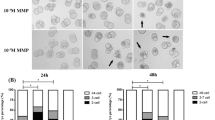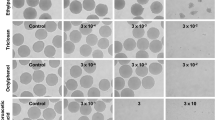Abstract
Backgrounds
The anti-inflammatory effect of andrographolide is widely accepted; however, its exact role in reproductive toxicity requires further elucidation. The embryonic stem cell test (EST) is a promising system for detecting the reproductive toxicity of drugs in vitro. In this study, we applied a prediction model to our EST data after classifying andrographolide according to published criteria. The possible mechanism of andrographolide reproductive toxicity was also studied.
Methods
Reproductive toxicity of andrographolide was evaluated in vitro EST model and in vivo mouse model. Human embryonic stem cells (ESCs) were cultured with different concentrations of andrographolide with or without N-acetyl-L-cysteine (NAC). Cell viability was assessed with MTT assay, and reactive oxygen species (ROS) level was measured with DCFH-DA assay. Gene and protein expression levels were measured with qRT-PCR and western-blot, respectively.
Results
Results showed that andrographolide exhibited strong reproductive toxicity according to the prediction model of the EST and mouse studies. An increase in ROS levels, damage to mitochondrial membrane potential, and induction of caspase-3 were observed in the andrographolide-treated human ESCs. Scavenging of andrographolide-induced ROS by NAC blocked these activities. Western blot and qRT-PCR analysis revealed that the nuclear factor erythroid-2-related factor 2 (Nrf2) protein and its target antioxidant genes were up-regulated after andrographolide treatment at certain concentrations. Furthermore, NAC treatment significantly increased the activity of the Nrf2 signaling pathway.
Conclusion
We demonstrated that andrographolide is a drug with strong reproductive toxicity, which resulted from ROS-mediated oxidative stress. In addition, the Nrf2 pathway appears to be involved in the NAC protection of human ESCs against andrographolide-induced cell apoptosis.
Similar content being viewed by others
References
Hossain, M. S., Urbi, Z., Sule, A. & Hafizur Rahman, K. M. Andrographis paniculata (Burm. f.) Wall. ex Nees: a review of ethnobotany, phytochemistry, and pharmacology. ScientificWorldJournal 2014, 274905 (2014).
Tan, W. S. D., Liao, W., Zhou, S. & Wong, W. S. F. Is there a future for andrographolide to be an anti-inflammatory drug? Deciphering its major mechanisms of action. Biochem Pharmacol 139, 71–81 (2017).
Shao, F. et al. Andrographolide alleviates imiquimod-induced psoriasis in mice via inducing autophagic proteolysis of MyD88. Biochem Pharmacol 115, 94–103 (2016).
Lee, J. C. et al. Andrographolide exerts anti-hepatitis C virus activity by up-regulating haeme oxygenase-1 via the p38 MAPK/Nrf2 pathway in human hepatoma cells. Bri Pharmacol 171, 237–252 (2014).
Selkoe, D. J. The therapeutics of Alzheimer’s disease: where we stand and where we are heading. Ann Neurol 74, 328–336 (2013).
Banerjee, M. et al. Cytotoxicity and cell cycle arrest induced by andrographolide lead to programmed cell death of MDA-MB-231 breast cancer cell line. Biomed Sci 23, 40 (2016).
Mishra, S. K., Tripathi, S., Shukla, A., Oh, S. H. & Kim, H. M. Andrographolide and analogues in cancer prevention. Front Biosci 7, 255–266 (2015).
Akbarsha, M. A., Manivannan, B., Hamid, K. S. & Vijayan, B. Antifertility effect of Andrographis paniculata (Nees) in male albino rat. Indian J Exp Biol 28, 421–426 (1990).
Burgos, R. A. et al. Testicular toxicity assessment of Andrographis paniculata dried extract in rats. J Ethnopharmacol 58, 219–224 (1997).
Allan, J. J. et al. Reproductive and fertility effects of an extract of Andrographis paniculata in male Wistar rats. Int J Toxicol 28, 308–317 (2009).
Yuan, Y. et al. Quinone reductase (QR) inducers from Andrographis paniculata and identification of molecular target of andrographolide. Fitoterapia 83, 1506–1513 (2012).
Rithaporn, T., Monga, M. & Rajasekaran, M. Curcumin: a potential vaginal contraceptive. Contraception 68, 219–223 (2003).
Lingampally, V. S. V. & Sabita Raja, S. Andrographolide: An effective anti-fertility agent for the control of Tribolium confusum. Asian J Plant Sci Res 2, 313–317 (2012).
Shinde, N., Chauhan, A. S., Gupta, S. K., Bodakhe, S. H. & Pandey, D. P. Antifertility studies of curcumin and andrographolide combination in female rats. Asian Pac J Reprod 4, 185–191 (2015).
Ismail, H.F. et al. Comparative study of herbal plants on the phenolic and flavonoid content, antioxidant activities and toxicity on cells and zebrafish embryo. J Tradit Complement Med 7, 452–465 (2017).
Scholz, G. et al. Prevalidation of the Embryonic Stem Cell Test (EST)-A New In Vitro Embryotoxicity Test. Toxicol In Vitro 13, 675–681 (1999).
Scholz, G., Pohl, I., Genschow, E., Klemm, M. & Spielmann, H. Embryotoxicity screening using embryonic stem cells in vitro: correlation to in vivo teratogenicity. Cells Tissues Organs 165, 203–211 (1999).
Marx-Stoelting, P. et al. A review of the implementation of the embryonic stem cell test (EST). The report and recommendations of an ECVAM/ReProTect Workshop. Alter Lab Anim 37, 313–328 (2009).
Seiler, A. E. & Spielmann, H. The validated embryonic stem cell test to predict embryotoxicity in vitro. Nat Protoc 6, 961–978 (2011).
Hong, E. J. & Jeung, E. B. Assessment of Developmental Toxicants using Human Embryonic Stem Cells. Toxicol Res 29, 221–227 (2013).
Sandstrom, J. et al. Development and characterization of a human embryonic stem cell-derived 3D neural tissue model for neurotoxicity testing. Toxicol In Vitro 38, 124–135 (2017).
Romero, A. C., Del Rio, E., Vilanova, E. & Sogorb, M. A. RNA transcripts for the quantification of differentiation allow marked improvements in the performance of embryonic stem cell test (EST). Toxicol Lett 238, 60–69 (2015).
Chen, X. et al. Transcriptomics analysis of early embryonic stem cell differentiation under osteoblast culture conditions: Applications for detection of developmental toxicity. Reprod Toxicol 69, 75–83 (2017).
Banerjee, M. et al. Andrographolide induces oxidative stress-dependent cell death in unicellular protozoan parasite Trypanosoma brucei. Acta Trop 176, 58–67 (2017).
Banerjee, A., Banerjee, V., Czinn, S. & Blanchard, T. Increased reactive oxygen species levels cause ER stress and cytotoxicity in andrographolide treated colon cancer cells. Oncotarget 8, 26142–26153 (2017).
Gottlieb, E., Armour, S. M., Harris, M. H. & Thompson, C. B. Mitochondrial membrane potential regulates matrix configuration and cytochrome c release during apoptosis. Cell Death Differ 10, 709–717 (2003).
Henry-Mowatt, J., Dive, C., Martinou, J. C. & James, D. Role of mitochondrial membrane permeabilization in apoptosis and cancer. Oncogene 23, 2850–2860 (2004).
Nguyen, V. S. et al. Specificity and inhibitory mechanism of andrographolide and its analogues as antiasthma agents on NF-kappaB p50. J Nat Prod 78, 208–217 (2015).
Castro-Falcon, G., Hahn, D., Reimer, D. & Hughes, C. C. Thiol Probes To Detect Electrophilic Natural Products Based on Their Mechanism of Action. ACS Chem Biol 11, 2328–2336 (2016).
Kim, Y. E. et al. Upregulation of NF-kappaB upon differentiation of mouse embryonic stem cells. BMB Rep 41, 705–709 (2008).
Morgan, M. J. & Liu, Z. G. Crosstalk of reactive oxygen species and NF-kappaB signaling. Cell Res 21, 103–115 (2011).
Kabe, Y., Ando, K., Hirao, S., Yoshida, M. & Handa, H. Redox regulation of NF-kappaB activation: distinct redox regulation between the cytoplasm and the nucleus. Antioxid Redox Signal 7, 395–403 (2005).
Ma, Q. Role of nrf2 in oxidative stress and toxicity. Annu Rev Pharmacol Toxicol 53, 401–426 (2013).
Elbini Dhouib, I. et al. A minireview on N-acetylcysteine: An old drug with new approaches. Life Sci 151, 359–363 (2016).
Poprac, P. et al. Targeting Free Radicals in Oxidative Stress-Related Human Diseases. Trends Pharmacol Sci 38, 592–607 (2017).
Cai, Z. et al. N-acetylcysteine protects against liver injure induced by carbon tetrachloride via activation of the Nrf2/HO-1 pathway. Int J Clin Exp Pathol 8, 8655–8662 (2015).
Zhong, C. et al. Generation of human haploid embryonic stem cells from parthenogenetic embryos obtained by microsurgical removal of male pronucleus. Cell Res 26, 743–746 (2016).
Mehta, A. et al. Pharmacological response of human cardiomyocytes derived from virus-free induced pluripotent stem cells. Cardiovasc Res 91, 577–586 (2011).
Gu, B. et al. Global expression of cell surface proteins in embryonic stem cells. PLoS One 5, e15795 (2010).
Author information
Authors and Affiliations
Corresponding authors
Rights and permissions
About this article
Cite this article
Huang, H., Cao, H., Xing, C. et al. Andrographolide induce human embryonic stem cell apoptosis by oxidative stress response. Mol. Cell. Toxicol. 15, 209–219 (2019). https://doi.org/10.1007/s13273-019-0024-x
Received:
Accepted:
Published:
Issue Date:
DOI: https://doi.org/10.1007/s13273-019-0024-x




